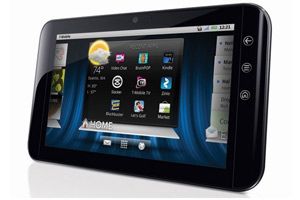LAS VEGAS: From massive screens to show off their product capa-bilities to dancers on a makeshift stage, companies use all kinds of gimmicks to draw footfalls to their booths at the Consumer Elec-tronics Show – one of the world’s largest annual technology fairs, in Las Vegas, Nevada.
But there’s one company that hasn’t bothered to take a booth and is yet making headlines. Google. The company’s Android software is everywhere – with every other smartphone or tablet being launched running on different versions of its Android operating system. Sony Ericsson, Samsung, Motorola, LG and Dell were just some of the companies that unveiled Android-based products.
 Google’s operating system – which is provided to companies for free so that they can build on it in any way and then install it on their gadgets – has given phone and laptop manufacturers, who were be-sieged by Apple’s iPhone and iPad, a new lease of life. Other smartphone makers like Research In Motion, which makes Black-berry, have also closed software that they do not share. Microsoft also charges for use of its Windows Phone software. So Google’s free and flexible platform has allowed companies like Sony, LG, Mo-torola and Samsung to step up and compete with Apple.
Google’s operating system – which is provided to companies for free so that they can build on it in any way and then install it on their gadgets – has given phone and laptop manufacturers, who were be-sieged by Apple’s iPhone and iPad, a new lease of life. Other smartphone makers like Research In Motion, which makes Black-berry, have also closed software that they do not share. Microsoft also charges for use of its Windows Phone software. So Google’s free and flexible platform has allowed companies like Sony, LG, Mo-torola and Samsung to step up and compete with Apple.
At CES 2011, there was a lot of excitement at the Motorola booth where the company unveiled two new Android-based smartphones – the Atrix 4G and the Droid Bionic. Atrix 4G is powered by An-droid 2.2 (Froyo), but will be upgradable to Android 2.3 (Gingerbread) later this year.
Samsung, which already has Galaxy S smartphones that run on Android, introduced the Infuse 4G, a super-thin Android 2.2-based 4G smartphone. Sony Ericsson unveiled the Xperia arc based on An-droid 2.3, the latest version of Google’s open mobile platform.
Acer introduced a new line of Liquid Mini Android phones. It fea-tures Acer’s customised user interface, which sits on top of An-droid 2.2.
Taiwan-based HTC launched three smartphone – ThunderBolt, Evo Shift and Inspire – all on Android 2.2 or Froyo.
In the tablet space, Motorola announced its Xoom tablet that runs on Android 3.0 also known as Honeycomb, the latest version which has been developed exclusively for tablets. LG launched its G Slate, a 4G tablet which also runs on Honeycomb, and is likely to hit the US in 2011. Dell launched the Streak 7, a tablet with 4G connectivity, a dual processor and of course, Android 2.2 upgradable to Honey-comb.
While Samsung only announced an upgrade on its Galaxy Tab – a WiFi only version will be available soon – the company did say that the Android platform has helped them enter the tablet and smartphone space. Samsung’s chief strategy officer Omar Khan said that using an Android platform with access to a number of apps has “led to sales of 1.5 million units of the earlier version of the Galaxy Tab, which had both 3G and WiFi capabilities”.
Samsung also unveiled the Galaxy Player, which it calls the “first Google-certified Android-based smart player”, and a rival to Ap-ple’s iPod. The Player was introduced in Korea last year and runs on Android 2.2, with access to 120,000 apps on the Android platform.
It wasn’t just smartphones and tablets. Android also made its pres-ence felt in the car space. At the automotive section, there were a number of applications on Android for smarter cars. For instance, automotive parts supplier Continental showed a head unit called AutoLinq with a range of apps that ran on Android. The device, still a
prototype, has applications such as navigation with real-time traf-fic; a vehicle diagnostic system that can tell a driver exactly what’s wrong with his car, like low-coolant or brake fluid, rather than just flash a check-engine light; speed limit data and safety features.
Other parts suppliers also demonstrated systems based on Android, like Audiovox’s Android-powered headrest-based entertainment system where people can connect to their Facebook pages, watch videos on YouTube and go online, all from the backset of their car.
While a lot of these systems are only prototypes, there seems to be a growing interest in connected car systems, as was clear from the huge space that cars got at CES 2011, and the flexibility of the An-droid platform will probably interest automakers too.
Whether smartphones, tablets or other applications, Google seemed to have its advertising being done for it very well by its users. Other smartphone manufacturers, which run on their own operat-ing systems, such as BlackBerry did have a presence but made no major announcements. Blackberry showcased its Playbook but didn’t give any details about the launch dates or pricing. Microsoft only showed its Windows Phone 7 launch devices and not much more. So this year, CES seemed to belong entirely to Android.


